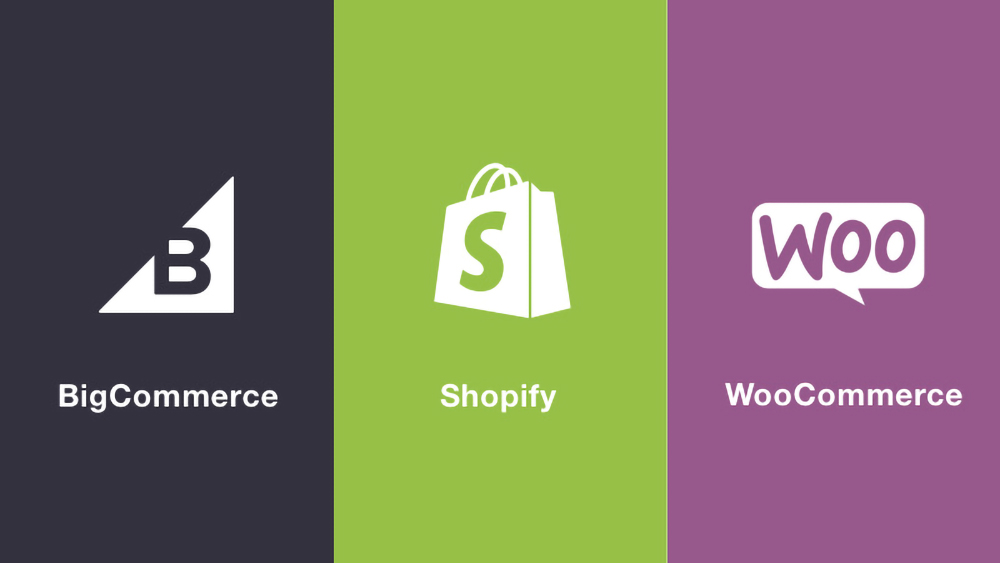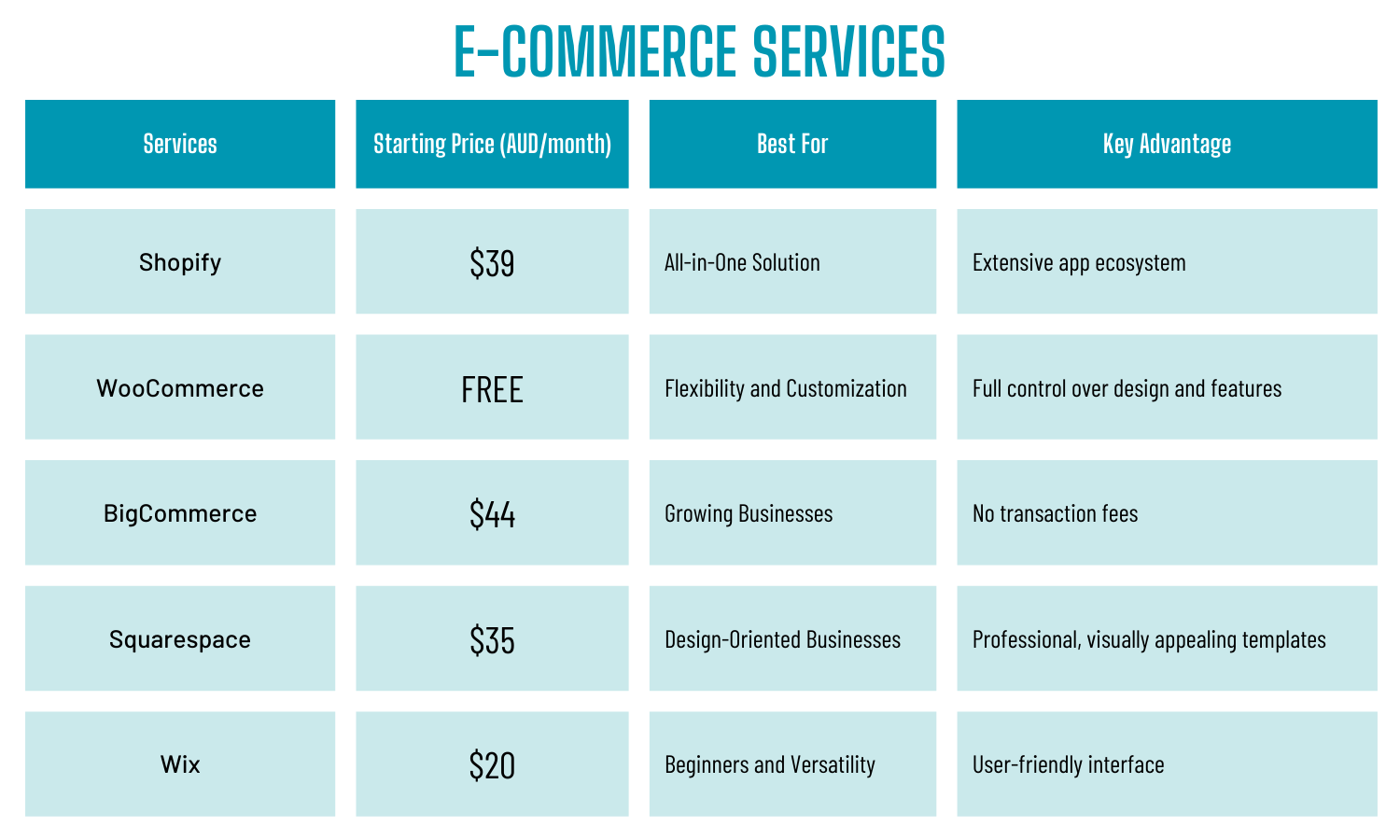Top 5 E-commerce Platforms for Australian SMEs in 2025
By JoeVu, at: Jan. 16, 2025, 5:09 p.m.
Estimated Reading Time: __READING_TIME__ minutes


Today, establishing a robust online presence is essential for Australian SMEs. Selecting the right e-commerce platform can significantly influence your business's growth, customer reach, and sales.
To assist you in making an informed decision, we've evaluated and compiled a list of the top 5 e-commerce platforms for Australian SMEs in 2025.
1. Shopify – Best All-in-One E-commerce Solution
Why It’s Great for Australian SMEs:
Shopify is renowned for its user-friendly interface, extensive features, and scalability, making it a popular choice among Australian SMEs.
Key Features:
- Easy-to-use drag-and-drop store builder
- Access to over 6,000 apps for added functionality
- Integration with local payment gateways like Afterpay and Zip Pay
- Built-in SEO and marketing tools
- 24/7 customer support
Pricing:
Plans start at $39 AUD/month, with options to scale as your business grows.
Pros:
- Simple setup process
- Suitable for both beginners and advanced users
- Extensive customization options
- Strong global and local support
Cons:
- Additional costs for premium themes and apps
- Transaction fees apply unless using Shopify Payments
Open-Source Integrations and Automation Tools:
- Zapier: Automate tasks by connecting Shopify with various apps and services.
- Shopify API: Develop custom integrations and functionalities tailored to your business needs.
- Shopify Flow: Automate workflows within your store to streamline operations.
Best For:
SMEs seeking an all-in-one solution that can scale with their business.
2. WooCommerce – Best for Flexibility and Customization
Why It’s Great for Australian SMEs:
WooCommerce is a free, open-source plugin for WordPress, offering high customizability and control over your online store.
Key Features:
- Seamless integration with WordPress
- Thousands of free and premium plugins
- Support for Australian payment gateways like eWAY and Stripe
- Full control over store design and features
- Strong community support
Pricing:
The core WooCommerce plugin is free; additional costs may include themes, hosting, and premium plugins.
Pros:
- Highly customizable
- No monthly fees for the core platform
- Large community and support options
- Ideal for content-driven e-commerce stores
Cons:
- Requires technical knowledge for setup and maintenance
- Potential additional costs for hosting and premium features
Open-Source Integrations and Automation Tools:
- Zapier: Connect WooCommerce with various apps to automate tasks.
- WooCommerce REST API: Facilitates custom integrations and mobile app development.
- AutomateWoo: Automate marketing and store management tasks within WooCommerce.
Best For:
SMEs desiring full control over their e-commerce store and familiar with WordPress.

3. BigCommerce – Best for Growing Businesses
Why It’s Great for Australian SMEs:
BigCommerce offers a robust, scalable platform with built-in features designed to support rapid business growth.
Key Features:
- No transaction fees on any plan
- Built-in SEO and marketing tools
- Multi-channel selling capabilities (e.g., eBay, Amazon, Facebook)
- Supports AUD and GST tax configurations
- 24/7 customer support
Pricing:
Plans start at $44 AUD/month, with a 15-day free trial available.
Pros:
- Comprehensive out-of-the-box features
- No additional transaction fees
- Excellent for multi-channel selling
- Scales effectively with growing businesses
Cons:
- Higher starting price point
- Limited selection of free themes
Open-Source Integrations and Automation Tools:
- Zapier: Automate workflows by connecting BigCommerce with other applications.
- BigCommerce API: Enables custom integrations and development of tailored solutions.
- Integromat (Make): Automate complex workflows and data synchronization between BigCommerce and other services.
Best For:
SMEs focused on scaling rapidly and selling across multiple channels.
4. Squarespace – Best for Design-Oriented Businesses
Why It’s Great for Australian SMEs:
Squarespace is known for its stunning templates and design flexibility, making it ideal for businesses where aesthetics are paramount.
Key Features:
- Award-winning design templates
- Simple drag-and-drop interface
- Built-in e-commerce tools
- Supports Australian currencies and tax settings
- Integration with social media platforms
Pricing:
E-commerce plans start at $35 AUD/month.
Pros:
- Visually appealing, professional templates
- User-friendly
Cons:
-
Limited Customization Options: While Squarespace offers a range of templates, users may find customization capabilities somewhat restricted, especially when compared to platforms like WordPress.
-
Limited E-commerce Features: Squarespace's e-commerce functionality may not be as advanced as other platforms, lacking features like extensive third-party app integrations and advanced inventory management.
Open-Source Integrations and Automation Tools:
-
Zapier: Connects Squarespace with over 1,000 apps, enabling automation of tasks such as adding form submissions to CRM systems or sending notifications.
-
Pipedream: Allows building and running workflows using the Squarespace API, facilitating custom integrations with other services.
-
Integrately: Provides instant integration between Squarespace and various applications, enabling automated workflows without coding.
Best For:
Design-focused SMEs seeking an aesthetically pleasing online presence with straightforward e-commerce capabilities.
5. Wix – Best for Beginners and Versatility
Why It’s Great for Australian SMEs:
Wix offers an intuitive drag-and-drop interface with a wide array of templates, making it accessible for users without technical expertise.
Key Features:
-
Over 500 designer-made templates
-
App Market with numerous add-ons
-
Integrated payment processing supporting AUD
-
SEO tools to enhance online visibility
-
24/7 customer support
Pricing:
Business and e-commerce plans start at $20 AUD/month.
Pros:
-
User-friendly with no coding required
-
Affordable pricing plans
-
Extensive template selection
-
Flexible design customization
Cons:
-
Templates are not interchangeable once chosen
-
May require multiple apps for full functionality
Open-Source Integrations and Automation Tools:
-
Velo by Wix: An open development platform that enables advanced web applications within the Wix environment.
-
Zapier: Automates tasks by connecting Wix with various third-party applications.
-
Integromat (Make): Allows creation of complex workflows between Wix and other services to automate business processes.
Best For:
Beginners and SMEs looking for an easy-to-use platform with versatile design options.
Comparison Table

Final Thoughts
Picking the right e-commerce platform is really important for the success of Australian SMEs in 2025. Consider your business needs, technical expertise, and growth plans when selecting a platform. Each of these platforms offers unique strengths tailored to different requirements, ensuring you can find the perfect fit for your online business.
At Glinteco, we specialize in integrating various e-commerce platforms—such as Shopify, WooCommerce, BigCommerce, Squarespace, and Wix - with your existing systems. Our team utilizes open-source tools and custom solutions to ensure seamless connections between your online store and essential business applications like ERP, CRM, and accounting software. This integration streamlines operations, enhances efficiency, and provides a cohesive, automated workflow tailored to your business needs.
To explore how Glinteco can assist in integrating your e-commerce platform, please reach out to us through our contact form or schedule a consultation via our Google Calendar link.





